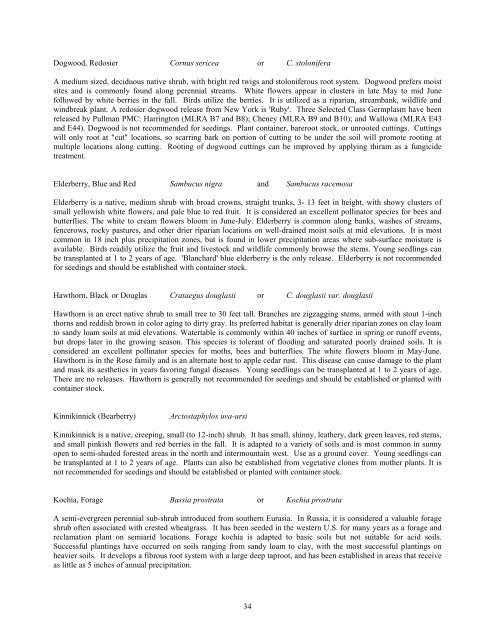Idaho Plant Materials Technical Note No. 24
Idaho Plant Materials Technical Note No. 24
Idaho Plant Materials Technical Note No. 24
Create successful ePaper yourself
Turn your PDF publications into a flip-book with our unique Google optimized e-Paper software.
Dogwood, Redosier Cornus sericea or C. stolonifera<br />
A medium sized, deciduous native shrub, with bright red twigs and stoloniferous root system. Dogwood prefers moist<br />
sites and is commonly found along perennial streams. White flowers appear in clusters in late May to mid June<br />
followed by white berries in the fall. Birds utilize the berries. It is utilized as a riparian, streambank, wildlife and<br />
windbreak plant. A redosier dogwood release from New York is 'Ruby'. Three Selected Class Germplasm have been<br />
released by Pullman PMC: Harrington (MLRA B7 and B8); Cheney (MLRA B9 and B10); and Wallowa (MLRA E43<br />
and E44). Dogwood is not recommended for seedings. <strong>Plant</strong> container, bareroot stock, or unrooted cuttings. Cuttings<br />
will only root at "cut" locations, so scarring bark on portion of cutting to be under the soil will promote rooting at<br />
multiple locations along cutting. Rooting of dogwood cuttings can be improved by applying thiram as a fungicide<br />
treatment.<br />
Elderberry, Blue and Red Sambucus nigra and Sambucus racemosa<br />
Elderberry is a native, medium shrub with broad crowns, straight trunks, 3- 13 feet in height, with showy clusters of<br />
small yellowish white flowers, and pale blue to red fruit. It is considered an excellent pollinator species for bees and<br />
butterflies. The white to cream flowers bloom in June-July. Elderberry is common along banks, washes of streams,<br />
fencerows, rocky pastures, and other drier riparian locations on well-drained moist soils at mid elevations. It is most<br />
common in 18 inch plus precipitation zones, but is found in lower precipitation areas where sub-surface moisture is<br />
available. Birds readily utilize the fruit and livestock and wildlife commonly browse the stems. Young seedlings can<br />
be transplanted at 1 to 2 years of age. 'Blanchard' blue elderberry is the only release. Elderberry is not recommended<br />
for seedings and should be established with container stock.<br />
Hawthorn, Black or Douglas Crataegus douglasii or C. douglasii var. douglasii<br />
Hawthorn is an erect native shrub to small tree to 30 feet tall. Branches are zigzagging stems, armed with stout 1-inch<br />
thorns and reddish brown in color aging to dirty gray. Its preferred habitat is generally drier riparian zones on clay loam<br />
to sandy loam soils at mid elevations. Watertable is commonly within 40 inches of surface in spring or runoff events,<br />
but drops later in the growing season. This species is tolerant of flooding and saturated poorly drained soils. It is<br />
considered an excellent pollinator species for moths, bees and butterflies. The white flowers bloom in May-June.<br />
Hawthorn is in the Rose family and is an alternate host to apple cedar rust. This disease can cause damage to the plant<br />
and mask its aesthetics in years favoring fungal diseases. Young seedlings can be transplanted at 1 to 2 years of age.<br />
There are no releases. Hawthorn is generally not recommended for seedings and should be established or planted with<br />
container stock.<br />
Kinnikinnick (Bearberry)<br />
Arctostaphylos uva-ursi<br />
Kinnikinnick is a native, creeping, small (to 12-inch) shrub. It has small, shinny, leathery, dark green leaves, red stems,<br />
and small pinkish flowers and red berries in the fall. It is adapted to a variety of soils and is most common in sunny<br />
open to semi-shaded forested areas in the north and intermountain west. Use as a ground cover. Young seedlings can<br />
be transplanted at 1 to 2 years of age. <strong>Plant</strong>s can also be established from vegetative clones from mother plants. It is<br />
not recommended for seedings and should be established or planted with container stock.<br />
Kochia, Forage Bassia prostrata or Kochia prostrata<br />
A semi-evergreen perennial sub-shrub introduced from southern Eurasia. In Russia, it is considered a valuable forage<br />
shrub often associated with crested wheatgrass. It has been seeded in the western U.S. for many years as a forage and<br />
reclamation plant on semiarid locations. Forage kochia is adapted to basic soils but not suitable for acid soils.<br />
Successful plantings have occurred on soils ranging from sandy loam to clay, with the most successful plantings on<br />
heavier soils. It develops a fibrous root system with a large deep taproot, and has been established in areas that receive<br />
as little as 5 inches of annual precipitation.<br />
34
















